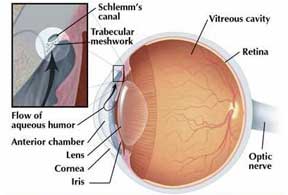|
| |
Glaucoma: Silent thief of
sight
Main
Article page |
Beauty articles
|
Health page |
Computers|
Diseases |
Education |
Entertainment |
Family
Business |Fitness|
Fruits and Vegetables
|
Jobs |
General |
Personality|
Technology
|
Tourism |
Useful Tips
Health Page|
Diseases and Remedies |
Articles

Glaucoma is an eye disorder in which the optic
nerve suffers damage, permanently impacting vision in the affected eye(s) and
progressing to complete blindness if untreated. It is often, but not always,
associated with increased pressure of the fluid in the eye.
The nerve damage involves loss of retinal ganglion cells in a characteristic
pattern. There are many different sub-types of glaucoma but they can all be
considered a type of optic neuropathy. One person may develop nerve damage at a
relatively low pressure, while another person may have high eye pressure for
years and yet never develop damage. Untreated glaucoma leads to permanent damage
of the optic nerve and resultant visual field loss, which can progress to
blindness.
Glaucoma can be divided roughly into two main categories, "open angle" and
"closed angle" glaucoma. Closed angle glaucoma can appear suddenly and is often
painful; visual loss can progress quickly but the discomfort often leads
patients to seek medical attention before permanent damage occurs. Open angle,
chronic glaucoma tends to progress at a slower rate and the patient may not
notice that they have lost vision until the disease has progressed
significantly.
Glaucoma has been nicknamed the "silent thief of sight" because the loss of
vision normally occurs gradually over a long period of time and is often only
recognized when the disease is quite advanced. Once lost, this damaged visual
field cannot be recovered. Worldwide, it is the second leading cause of
blindness.Glaucoma affects 1 in 200 people aged fifty and younger, and 1 in 10
over the age of eighty. If the condition is detected early enough it is possible
to arrest the development or slow the progression with medical and surgical
means.
What is glaucoma?
Glaucoma is a group of eye diseases in which
the normal fluid pressure inside the eyes slowly rises, leading to vision
loss or even blindness. Open-angle glaucoma is the most common form of the
disease.
What causes it?
Clear fluid flows in and out of small space at
the front of the eye called the anterior chamber. This fluid bathes and
nourishes nearby tissues. If this fluid drains too slowly, pressure builds
up and damages the optic nerve. Though this buildup may lead to an increase
in eye pressure, the effect of pressure on the optic nerve differs from
person to person. Some people may get optic nerve damage at low pressure
levels while others tolerate higher pressure levels.
Who is most likely to get it?
Glaucoma is a leading cause of blindness in the
United States. Although anyone can get glaucoma, the following people are at
higher risk:
- African Americans over
age 40
- Everyone over age 60,
especially Mexican Americans
- People with a family
history of glaucoma.
What are the symptoms?
At first, there are no symptoms. Vision
stays normal, and there is no pain.
However, as the disease progresses, a
person with glaucoma may notice his or her side vision gradually
failing. That is, objects in front may still be seen clearly, but
objects to the side may be missed. As the disease worsens, the field of
vision narrows and blindness results.
How is it detected?
Many people may know of the "air puff" test
or other tests used to measure eye pressure in an eye examination. But
this test alone cannot detect glaucoma. Glaucoma is found most often
during an eye examination through dilated pupils. Dilating pupils
involves putting drops into the eyes during the exam to enlarge the
pupils. This procedure allows the eye care professional to see more of
the inside of the eye to check for signs of glaucoma.
How can it be treated?
Although open-angle glaucoma cannot be
cured, it can usually be controlled. The most common treatments are
as follows:
-
Medications: These may be either in the form of
eyedrops or pills. Some drugs are designed to reduce pressure by
slowing the flow of fluid into the eye. Others help to improve
fluid drainage.
For most people with glaucoma, regular use of medications will
control the increased fluid pressure. But these drugs may stop
working over time, or they may cause side effects. If a problem
occurs, the eye care professional may select other drugs, change
the dose, or suggest other ways to deal with the problem.
- Laser
surgery: During laser surgery, a strong beam of light
is focused on the part of the anterior chamber where the fluid
leaves the eye. This surgery results in a series of small
changes that make it easier for fluid to exit the eye. Over
time, the effect of laser surgery may wear off. Patients who
have this form of surgery may need to keep taking glaucoma
drugs.
-
Surgery: Surgery can also help fluid escape from the
eye and thereby reduce the pressure. However, surgery is usually
reserved for patients whose pressure cannot be controlled with
eyedrops, pills, or laser surgery.
What research is being done?
Scientists in the United States are
conducting research to learn what causes glaucoma and to improve
its diagnosis and treatment. For example, researchers have
discovered genes that could help explain how glaucoma damages
the eye.
NEI is funding a number of studies
to find out what causes fluid pressure to increase in the eye.
By learning more about this process, doctors may be able to find
the exact cause of the disease and learn better how to prevent
and treat it. NEI supports studies to learn more about who is
likely to get glaucoma, when to treat people with increased
pressure, and which treatment to use first. NEI also supports
clinical trials of new drugs and surgical techniques that show
promise against glaucoma.
( Courtesy: National Eye Institute
http://www.nei.nih.gov/ )
| |
|



